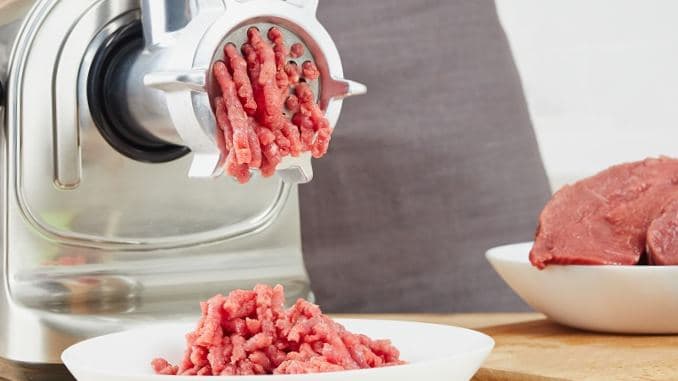A meat grinder, also known as a meat mincer, is a vital kitchen appliance designed for the sole purpose of chopping or mixing meat or food into smaller pieces without the support of any other item.
While it always comes in handy for the majority of home cooks to prepare meat, many don’t have the know-how about how this kitchen gadget works.
If you’re also one of them, this article will clear your path. So keep reading to find out the favorable answer!
Related:
How Does A Meat Grinder Work?
Generally, the meat to be minced is put on the tray. From there, it enters a feeding tube and reaches the extruder, which pushes it to the outside.
The outer portion of the tube has a grinding blade and plates. It is then cut down by the blade and pushed forward through the attached plates to come out in the desired form.
Additional attachments such as the sausage stuffer are also encouraged to fill the sausage with the grinder.
The Main Components
Delving deeper into the working principle, it’s crucial to understand its essential components.
- The tray/hopper: This is the topmost part of the grinder. Meat is usually placed on this hopper.
- Feeding tube: Right below the tray, there’s a T-shaped tube with a tray attached at the top and some small parts attached at the lower proportion.
- Screw ring: It’s on the outer portion of the feeding tube.
- Extruder: It is attached to the feeding tube to push things out.
- Cutting blade: It is placed right at the end of the feeding tube to cut the meat into pieces.
- Motor: This is the most vital part that determines the sturdiness quality. Typically, a household grinder often has a 300-500 Watt motor.
- Grinder plate: It has small holes that allow the ground paste to come out of the grinder after grinding. The holes can be of different sizes that give the output to come out in varying sizes.
- The pusher: Primarily made of plastic, it forces or pushes out everything inside the feeding tube.
- Sausage stuffer: This is an additional accessory attached to the screw ring to prepare ground meat sausage.
Related:
- Best manual meat grinders
- Best meat grinder attachments for KitchenAid stand mixers
- Best meat grinder for chicken bones
FAQ’s
Is it worth the investment?
Yes, there are several reasons why it’s worth investing in this kitchen gadget over purchasing products from the supermarkets.
- Quality: Ground meat in the marketplace is not of excellent quality compared to a fresh and clean homemade one. Also, grinding at home means that you can control the quality and ensure everything is free of any preservatives.
- Cost-benefit: Purchasing from a supermarket or a butcher’s shop can cost extra dollars while grinding it at home can be more economical in the long run.
- Customized: You can experience different tastes and textures from different cuts when grinding it at home and seasoning it with your favorite ingredients.
- Unique Attachments: A good grinder also provides a wide range of unique attachments to get the different forms of the final results. From making sausages to grinding vegetables, you can let the attachments do the job.
What can you use it for?
Initially, just as the name implies, its basic application is to grind meat of any type with ease. Additionally, you can also prepare customized sausages with different recipes using the grinder.
A good rule of thumb is to choose a piece of meat that contains fine marbling and visible fat content. Some fresh and juicy cuts that are suitable for grinding include chuck cut, brisket cut, sirloin cut, round cut, hanger cut, and short eye rib cut.
These cuts have a high meat-to-fat ratio which allows for the mouth-watering flavor of the finish.
Besides, it is also helpful for grinding various vegetables such as onions, peppers, garlic, tomatoes, cilantro, cucumbers, and peppers for homemade pickles or sauces.
Not only that, a grinder model designed for heavy-duty tasks is a great go-to option for grinding raw bones of chicken, duck, and rabbit. However, the grinder is not recommended to grind hard bones such as that of a goat, sheep, or cow.
Do you need to sharpen the grinder blades and plates?
For excessive use, you often notice that the blades and plates of the grinder become blunt.
Therefore, it’s vital to sharpen the blades and plates for effective use. However, note that the process with the plates is called “flattening” instead of “sharpening” with the purpose of creating a smooth surface.
Concerning the blades, there are a total of four surfaces that require sharpening.
The Bottom Line
To summarize, the working principle of this kitchen appliance is not sophisticated and requires little effort at all.
Noteworthy, meat grinding can be a pleasant and joyful experience to save money while your meat is free of preservatives and chemicals.
Finally, if you have any questions or experience with any kitchen appliances, please contact us or leave some comments below.

